Whoever ran Craftd’s SEO campaign recently deserves a raise.
Based on estimates (of traffic, conversions and AOV) – Craftd could have added over £2m in annual revenue from organic search from their work over the last 18 months.
Quick note: I did not work on this. I have no idea who did. I’ve just taken the time to break down some of the elements that are clearly working for the brand and seen their organic search traffic improve considerably.
Basic Overview: What’s This All About?
In this reverse case study, I’m breaking down what Craftd London is doing right from an SEO perspective – and why it’s working.
You’ll see:
- A clear breakdown of smart SEO plays
- Highlights of strong content, structure, and CRO
- A few quick-win tips at the end for improvement
What I’ll analyse:
- Homepage
- Menu structure
- Category pages
- Product listings
- Product pages
- Technical SEO
- Blog
- Brand authority
- Social proof
- Backlinks
- Financial view
This isn’t a teardown.
It’s a celebration of what works, with a few pointers on how to go even further.
About Craftd London
- Premium men’s jewellery brand with bold, modern designs
- Specialises in chains, pendants, bracelets, and rings
- Uses 18K gold, sterling silver, and durable materials
- Offers a lifetime guarantee on all products
- Trusted by over 1 million customers worldwide
- 7,000+ five-star reviews
- Free shipping on orders over $100
- Strong focus on quality, style, and brand loyalty
Estimated Traffic
- Strong UK Market Presence with Global Reach
- Craftd London generates 133K estimated global organic traffic (via Ahrefs).
- The UK and US are the dominant markets, USA driving 56k and the UK driving 45K visits, while Canada (6.4K) also contributes.
Estimated Traffic Value
Craftd London is driving an impressive $79.8k worth of organic traffic. This figure is an indication of the value of the traffic the website is attracting from search engines, based on the current rankings of its organic keywords. This is essentially the cost that the brand would have to spend on paid search ads to generate the same amount of traffic.


Keyword Rankings

Craftd London has built a strong organic presence, ranking for 8.3K organic keywords globally, with the majority of rankings and traffic coming from the UK (4.7K keywords), followed by Canada (669) and the US (1.1K).
Their SEO strategy is delivering strong organic rankings, with a solid presence in the top 10 positions on Google:
- 584 keywords in Positions 1-3

- 702 keywords in Positions 4-10

- 640 keywords in Positions 11-20

The Homepage: First Impressions
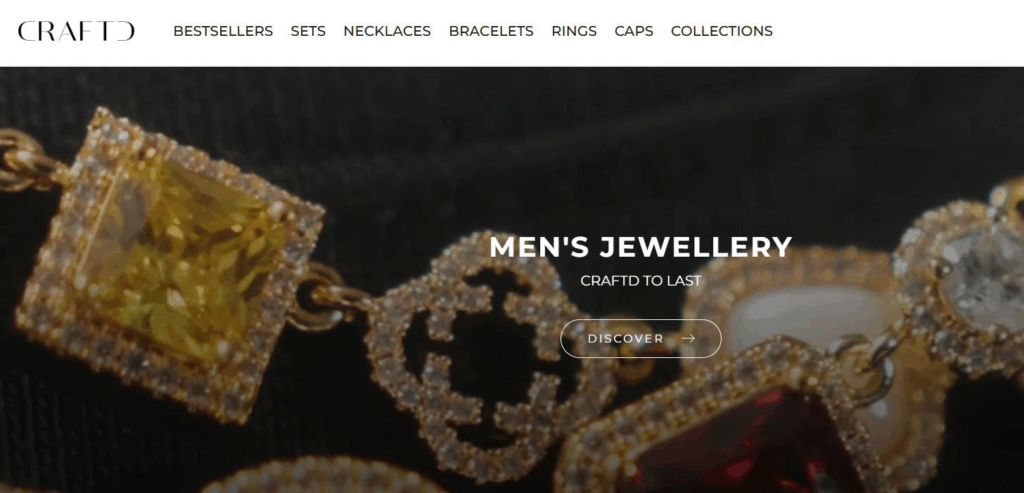
What They’re Doing Right:
Right off the bat, we can see a clear H1 with the primary keyword: Men’s Jewellery. Even though this is basic SEO practice, people still make the mistake of not implementing a clear H1 with the primary keyword they’re trying to rank for on the homepage.
What They Need to Improve On:
Craftd should include intro text under the H1. Doing this gives Google more context, helps rank for long-tail keywords, and quickly tells visitors what the brand’s all about.
Example: Premium men’s jewellery made to last – from chains to statement rings. Built for everyday wear, designed to stand out.
Technical: Are They Built to Rank?
Menu Structure and Navigation
What They’re Doing Right:
Craftd displays the product categories in the main menu. These are Bestsellers, Sets, Necklaces, etc.
Why Is It Good for SEO?
- Search engines crawl and index pages linked in the main menu more efficiently.
- Ensures product category pages are easily discoverable and ranked.
Passes Link Equity
- The main menu is site-wide, meaning it distributes authority to key category pages.
- Strengthens SEO signals for these pages, helping them rank higher.
Strengthens Site Structure & Relevance
- Internal linking from the main menu reinforces site hierarchy, making it easier for Google to understand relationships between pages.
- Prioritises money pages (categories) for better rankings.
Why Is It Good for Users and UX?
- A clear, structured menu helps users find products faster, reducing frustration.
- Fewer clicks = Better UX = Higher conversions & lower bounce rates.
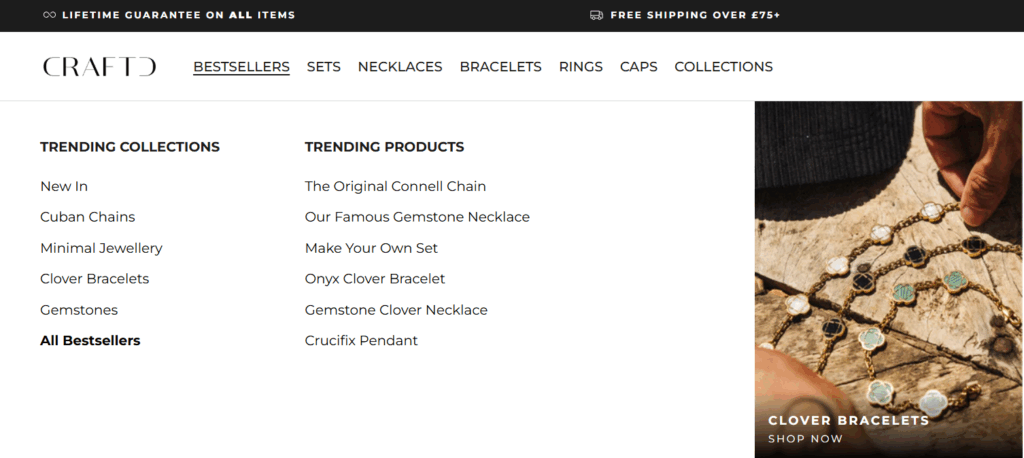
Above, we can see that Craftd has included internal links to their subcategory product pages.
Why Is This Good for SEO?
Same as the points mentioned above for the Product Category pages. Subcategory product pages are usually found deeper in your site. These are also money pages and they need to be discovered and indexed.
Search engines crawl deeper pages faster when linked from the main menu. It improves UX because users can easily find specific products they are looking for.
This reduces bounce rates by driving users directly to your money pages, increasing the potential of more conversions/sales.
The simplistic design is also worth pointing out. It doesn’t overwhelm users with tons of links. This site structure clearly meets the user’s needs.

Breadcrumb Navigation for Better UX & SEO
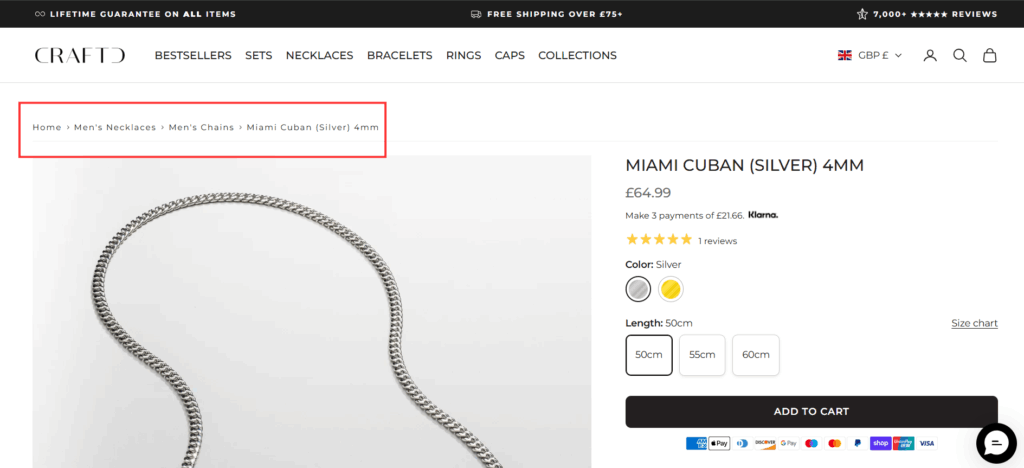
What They’re Doing Right:
Craftd London effectively implements breadcrumb navigation (e.g., Home → Men’s Necklaces → Men’s Chains → Miami Cuban (Silver) 4mm).
Why It’s Effective:
- Makes for better UX by providing a clear path back through categories.
- Helps search engines understand site structure, improving SEO.
- Reduces bounce rates by making it easier for users to explore related products.
Category Pages – Optimised H1 & Intro Text for SEO & Engagement

What They’re Doing Right:
Craftd London’s category pages have a clear H1 targeting the primary keyword and supporting introductory text below it.
Why It’s Effective:
- The H1 reinforces the page’s relevance for search engines and aligns with user intent.
- The intro text provides context, naturally incorporating keywords while improving readability.
- Helps both SEO and conversion by setting expectations and reinforcing brand positioning.
Effective Product Filtering for UX & Conversions
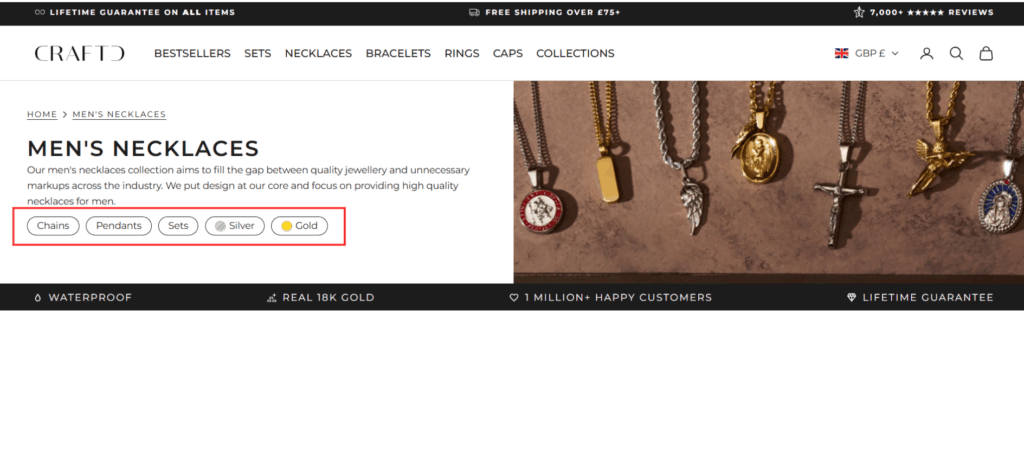
What They’re Doing Right:
Craftd London includes clickable product filters (e.g., Chains, Pendants, Sets, Silver, Gold) on category pages.
Why It’s Effective:
- Improves user experience by allowing quick navigation to relevant products.
- Helps customers find what they want faster, reducing friction in the buying process.
- Boosts conversion rates by streamlining product discovery.
Additionally Filtering Options
Craftd has implemented multiple filtering options on their product pages, allowing users to easily refine their search based on color, product type (e.g., chains, gemstones, pendants, sets), availability, and price.
Users can find exactly what they’re looking for with a click of a button, leading to more conversions.

Product Display Strategy
- The site limits product display to 50 items per category page.
- A “Load More” button allows users to reveal additional products.
Why This Works Well:
- Improves page speed by reducing initial load time.
- Prevents product lists that overwhelm the customer.
- Encourages engagement, as users actively browse and click for more.
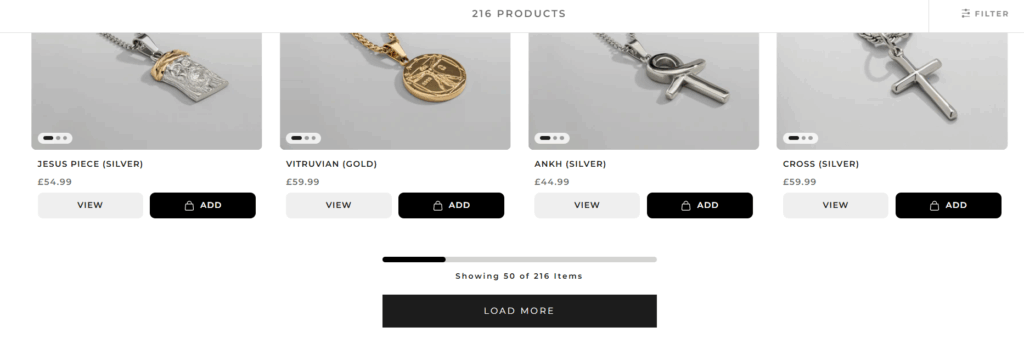
However, this is only effective if implemented search engine-friendly. When done right, “Load More” can still be crawlable and indexable if the content is served in a way that search engines can access, such as providing a “No JS” version with static links for pagination.
What to Improve:
When JavaScript is disabled, the “Load More” button is not functional.
Search engines may fail to access all the products or content on the page.
Why It’s Bad for SEO:
- Incomplete indexing: Search engines can’t crawl and index all the product pages, which impacts visibility in search results.
- Missed opportunities: Products not indexed by search engines are less likely to appear in search results, reducing organic traffic.
- Ranking issues: If the content is not discoverable, it won’t contribute to the site’s overall SEO efforts, affecting keyword rankings.
Product Listings
High-Quality Product Images
Craftd uses high-quality images that not only showcase the products, but also include visuals of them being worn. This allows shoppers to immediately understand the product, even if they don’t read the description right away.
Image Optimisation
Craftd has optimised their product images, ensuring fast loading times with small file sizes (e.g., 71.7KB). This improves site speed, providing a better user experience and positively impacting SEO by reducing page load times.

Product Videos on Product Description Pages
Craftd gives customers a great shopping experience by including videos of real people using their products. This helps them see the product in action, builds trust, and provides a more immersive and relatable experience.
Result? Higher engagement and conversions.

Product Descriptions
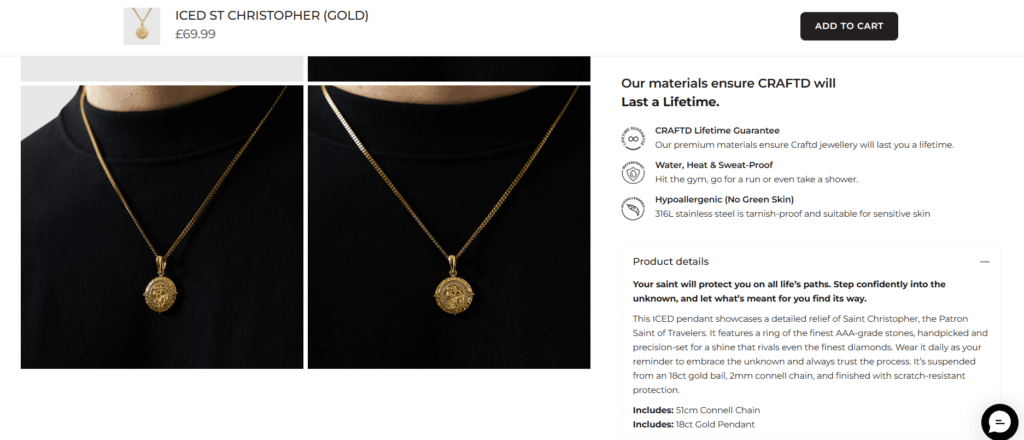
Why They’re Effective:
Emotional Appeal and Storytelling
Storytelling is a powerful way to make a product resonate emotionally with potential customers. In this case, it’s not just a pendant, but something that symbolises protection on life’s journey, which speaks to a deeper need for security and guidance.
Psychological Strategy
Craftd taps into the buyer’s emotions and aspirations by associating the pendant with personal growth, protection, and confidence. The line “Your saint will protect you on all life’s paths” is a powerful emotional appeal, implying that the product is not just a piece of jewellery but also a source of comfort and support.
This creates an emotional connection that could lead to the consumer perceiving the pendant as something beyond a material possession, almost like a talisman or personal symbol of protection.
Association with Prestige and Quality
Associating the product with a luxury standard (like AAA-grade stones and diamond-like shine) elevates the perceived value, making the buyer feel as if they are purchasing something prestigious and worthy of admiration.
Product Detailing and Quality Assurance
Providing clear details about the material and additional features (like scratch-resistant protection) gives the buyer confidence in the product’s longevity and functionality.
Subtle Persuasion Through Exclusive Terms
Words like “handpicked,” “precision-set,” and “18ct gold” elevate the product in the eyes of the buyer, suggesting craftsmanship and attention to detail. These terms subtly persuade the buyer that the product is exclusive and rare, making it seem more desirable.
Optimised Product Descriptions with Relevant Keywords
Craftd London has effectively integrated relevant, targeted keywords into their product descriptions, helping improve their search engine visibility and ensuring the content is aligned with user search intent. This is good for both UX and SEO.
The product description incorporates strategic keywords that highlight quality (AAA-grade stones, 18ct gold), material specifics (Connell chain), and niche appeal (Saint Christopher, ICED pendant). These keywords are designed to attract search engine traffic from users looking for high-end, meaningful, or specific types of men’s jewelry, increasing visibility in relevant searches.
Accessible Accordions for Product Information
Accordions improve UX by keeping pages clean and reducing visual clutter, allowing users to focus on key content. They enable quick access to detailed information without overwhelming the page.
When accordions are not set up properly (e.g., relying on JavaScript to load content), search engines may fail to crawl the hidden content.
If the content is not in the initial HTML or accessible without JavaScript, search engines might not index it, leading to missed opportunities for ranking.
Properly configured accordions should have content in the HTML, with JavaScript only used for toggling visibility, ensuring both users and search engines can access it.

Craftd London uses accordions on their product pages. These ensure the content is part of the initial HTML and accessible without JavaScript.
This improves both SEO and user accessibility, allowing search engines to crawl the content and users to easily view important details without technical barriers.

Clear Shipping and Return Information

Craftd London provides clear shipping details directly on the product page, including next-day UK delivery options, free delivery on orders over £75, and easy returns & exchanges. This transparency builds trust with customers, making the purchasing decision easier.
Flexible Payment Options with Klarna

Craftd London offers Klarna instalment payments on product pages, allowing customers to split their purchase into manageable payments. This increases affordability and reduces hesitation, making it easier for shoppers to commit to a purchase.
Related Products Section with Internal Linking
Craftd London includes a “Related Products” section with links to relevant product pages, encouraging customers to explore more items. It also improves internal linking, which benefits SEO by distributing link equity across the site.
Product pages typically get natural links from forums and other websites which can mean scaling internal linking back to other product pages can be a great way to drive SEO performance.
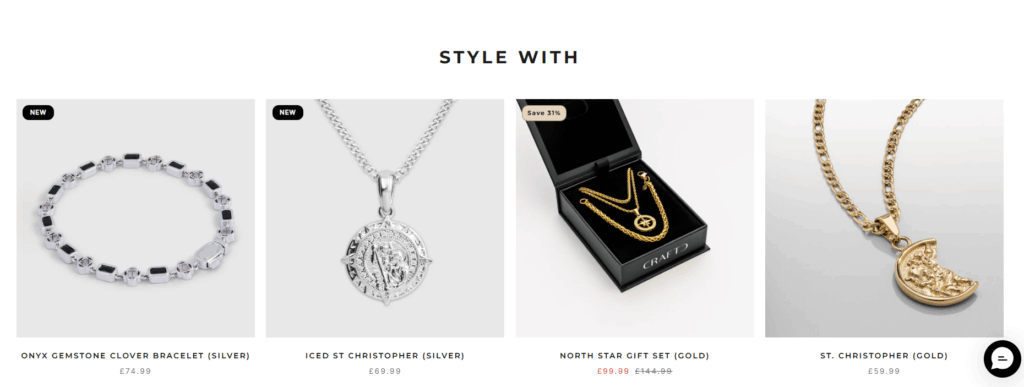
Use of Schema Markup
Craftd London has implemented the correct schema markup, including Product Schema Markup to enhance search engine visibility with rich snippets, and BreadcrumbList Schema Markup to improve navigation and help search engines understand the site structure. This boosts both SEO and user experience by providing clear, structured data.

What Improvements Can Be Made
Craftd should combine the AggregateRating schema with the existing Product schema to display average ratings and reviews directly in search engine results. This can boost a site’s visibility in SERPs by showing rich snippets, which can increase click-through rates and drive more organic traffic to the site.
Including AggregateRating also boosts the credibility of product listings, making them more appealing to potential customers.
EEAT & Trust Signals: Credible at a Glance?
Craftd London builds credibility by showcasing mentions from reputable sources.
Trust indicators – Reviews are prominently placed in the top right corner, reinforcing legitimacy and social proof.
Boosts user confidence – Seeing external validation helps reassure potential customers and signals to Google that the brand is authoritative.
The footer showcases more EEAT signals every business needs to have/display on their site. The TOS, Privacy Policy, Shipping and Refund Policy pages, etc.
This also shows Google that the business is a legit entity. Google prioritises trustworthy sites, especially for eCommerce. Clearly stated policies signal legitimacy and transparency, reducing the risk of being seen as a low-quality or scammy site.
Customers feel more secure when they know how their data is used (Privacy Policy) and what to expect in terms of returns, refunds, and shipping.
They reduce friction in the buying process leads to higher conversion rates and fewer chargebacks.
Many countries legally require Privacy Policies (GDPR, CCPA) and clear TOS for consumer protection.
Having these pages ensures compliance, reducing the risk of penalties or being delisted from search results.

Strong Trust Signals in the Footer
Craftd London includes recognisable trust signals in the footer, such as social media icons (Instagram, Facebook) and secure payment logos (PayPal, Visa, Mastercard, American Express). These are instantly familiar to users, reinforcing trust by associating the brand with well-known platforms and secure transactions.
When shoppers see logos they recognise and trust, they feel more comfortable making a purchase.
Internal Links on the Homepage
These are not links in the main navigation. These are links users can click on when they scroll further down on the page. These links go to product category pages.
The homepage typically has the most backlinks and authority.
Linking to product pages distributes this authority, boosting their rankings in SERPs. A well-structured internal link setup guides visitors to conversion pages efficiently.
Linking to products and categories from the homepage boosts SEO by improving crawlability, passing authority, enhancing UX, and reinforcing keyword relevance. Results? Higher rankings and more conversions.

Internal Links Pointing to Blog Posts on the Site
This improves crawlability, allowing Google bot to find more content on the site. Your homepage has the most backlinks and authority. Linking to blog posts distributes SEO value, improving rankings.
Internal links from your homepage:
- Drive visitors to valuable content, increasing dwell time and reducing bounce rates.
- Guide users through the buyer’s journey, leading to conversions.

Effective Trust Signals on Product Pages
Craftd London incorporates trust signals on their product pages, including familiar secure payment logos (PayPal, Visa, Mastercard, American Express). These signals are widely recognised by users, creating a sense of security and trust.
When customers see logos they already associate with secure transactions and credible platforms, it reassures them that the site is legitimate and that their personal and payment information will be handled safely.

Content: Is It Up to Scratch?
Blog
Craftd London’s blog section is a good addition but could definitely do with better SEO.
- Many blog posts have thin content, relying more on images rather than SEO-optimised text. Adding more in-depth, keyword-rich content would help with search rankings.
- Internal linking is inconsistent. Some blogs link to product pages while others don’t. A consistent internal linking strategy would help distribute link equity and drive traffic to product pages.
- They are missing opportunities to create valuable, informative blog content that could rank for informational keywords and guide readers toward relevant products. A well-planned content strategy focusing on buyer intent and product relevance would improve their SEO and conversion potential.
- There is a strong opportunity to leverage top-of-funnel (TOFU) traffic generated through informational blog content to grow the email list. Craftd London could capture emails and nurture those leads through email marketing to drive future sales. This would not only boost the ROI of their content efforts but also build a more direct and engaged customer base.


Top Pages
Craftd London’s traffic-driving pages show strong e-commerce SEO execution.
Craftd London’s top traffic pages are the homepage, product category pages, and product description pages, which indicates:
- Effective SEO on high-intent pages that directly contribute to sales.
- A strong internal linking structure that ensures users and search engines can easily navigate to key pages.
- Optimised product and category pages that align well with user search intent.

What They’re Doing Well & Why It’s Working
1. Strong Keyword Rankings for Commercial & Transactional Keywords
Craftd London ranks for high-intent, buyer-focused keywords related to their products, such as:
- Men’s necklaces
- Men’s rings
- Mens’ chains
Why It’s Working:
They target keywords with clear commercial intent, meaning searchers are already interested in purchasing. This translates to higher conversion rates.
2. Well-Optimised Category & Product Pages
Their category pages and product description pages make up a significant portion of their top-ranking pages. These are properly optimised with:
- Relevant keywords in titles, URLs, and meta descriptions
- Detailed product descriptions that include keyword-rich content
- Internal linking from category pages to products, improving discoverability
Why It’s Working:
Google favours well-structured category and product pages that clearly describe what’s being sold, improving rankings for specific product-related search queries.
Branded SEO: How Do They Appear in Search?
Craftd London is already seeing strong rankings for its branded keywords, demonstrating the effectiveness of their SEO strategy in owning their brand’s presence in search results. Branded search queries are key opportunities because they not only drive high-quality traffic but also convert much higher than non-branded terms.
These searches are typically made by potential customers already familiar with the brand and more likely to purchase.
Owning the conversation around your brand in the SERPs is critical, especially in the competitive world of eCommerce. When your brand ranks for these terms, you:
- Increase customer trust by showing up prominently when users search for your name or related queries.
- Drive higher average order value (AOV) and lifetime value (LTV), as customers coming from branded searches are often more engaged and loyal.
- Reduce reliance on third-party affiliates, keeping more profits in-house and eliminating potential issues with outdated or invalid coupon codes.
As you can see in the screenshot below, Craftd London is ranking strongly for various branded keywords, capturing valuable traffic and building brand authority.

What They Can Improve On: Capitalising Further on Branded SEO
While Craftd London is performing well with its branded keywords, there is still room to fully capitalise on this strategy. Currently, the brand ranks position 4 for the high-converting branded keyword “Craftd London discount code.” This is a valuable search term that signals high intent from users looking to make a purchase, but third-party coupon sites are outranking the brand.
Craftd London already has a dedicated landing page for this keyword, but it needs to be optimised further to fully capture this traffic.

Brand and Social Signals
Branded Search Traffic
Craftd London generates 2.3K monthly visits from branded search traffic, meaning thousands of users are actively searching for the brand by name. This suggests successful marketing, social media presence, and PR efforts.
Branded search queries often result in higher CTRs because users already intend to visit the site. This improves engagement signals, which can boost overall SEO performance.
Branded search traffic typically comes from high-intent users who are closer to purchasing. These visitors convert at higher rates compared to non-branded searchers.

Key Takeaways: What’s the Verdict?
I made it clear at the start of this article – whoever has been in charge of this campaign deserves a raise.
What They’re Doing Well:
- Robust EEAT Implementation: Demonstrates trustworthiness and authority through reviews, publications, and comprehensive policies.
- Strategic Internal Linking Architecture: Maximizes authority distribution and user navigation across key product and content pages.
- User-Centric Navigation Design: Streamlines product discovery with clear menus and breadcrumbs.
- Advanced Product Filtering System: Enhances user experience and conversion rates by enabling precise product searches.
- Compelling, Emotionally Driven Product Content: Utilizes storytelling and psychological triggers to boost engagement and conversions.
- Effective Mobile Conversion Optimization: Implements a sticky “Add to Cart” button for a seamless mobile shopping experience.
- Comprehensive Schema Markup Strategy: Enhances search engine understanding and rich snippet display.
- Successful International SEO Implementation: Targets global markets with effective hreflang tagging.
- High-Quality Backlink Acquisition: Secures authoritative backlinks from reputable sources, boosting domain authority.
- Strong Brand Presence and Social Media Engagement: Drives branded traffic and leverages social platforms for brand visibility and sales.
What they could improve n:
- Add Intro Text Under Homepage H1: Provide more context.
- Ensure “Load More” Button is Search Engine Friendly: Avoid relying solely on JavaScript.
- AggregateRating Schema Integration: Combine with Product schema for rich snippets.
- Improve Mobile Page Speed: Optimise LCP, FCP, and Speed Index.
- Optimise Desktop LCP: Further enhance load speed.
- Avoid Excessive JavaScript Reliance: Ensure essential content is accessible without JavaScript.
- Enhance Blog Content: Add in-depth, keyword-rich text and improve internal linking. Informational blog content can be used to attract TOFU traffic and convert it into email subscribers. This creates a pipeline for nurturing leads and driving future sales via email marketing.
- Capitalise further on branded keywords by optimising existing landing pages, like the “Craftd London discount code” page, to better capture high-intent traffic, reduce reliance on third-party sites, and drive higher conversions.